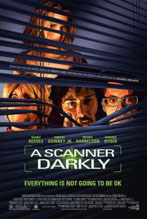
Arch
443/646: Architecture and Film
Fall 2007
A Scanner
Darkly (2006)
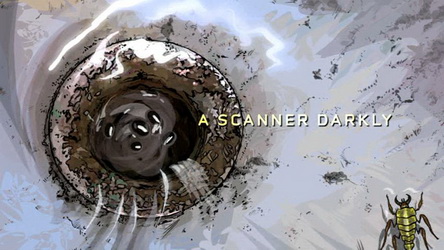
 |
Arch
443/646: Architecture and Film A Scanner
Darkly (2006) |
 |
Discussion Questions:
Remember, your images are ABOVE your name.
Please answer the questions below. Use paragraph form. Your answer should be around 400 words. Email me your responses in Word .doc format to: tboake@sympatico.ca I will be posting these each week after the class. You should be prepared to deliver your answer in class -- but paraphrase, do not read it. THINGS TO KEEP IN MIND WHEN ANSWERING THESE QUESTIONS: I am looking for specific observations about the film and the relationship to aspects of the Uncanny that we have examined. Both the filming method and the subject of the film will figure into these answers. Information on the filming technique: Article from Wired on Scanner Darkly and the film technique. link |
| 1. | 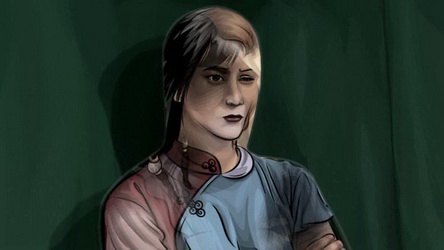 |
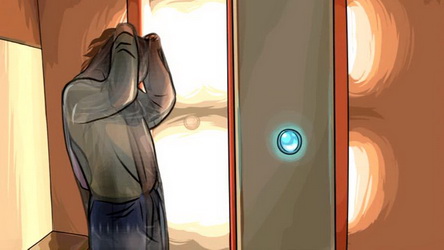 |
|||||
Adam Brady The scramble suit is the uniform of an undercover narcotics agent at
the sheriff’s department in Orange County. The suit is can fool
the latest in voice and facial recognition technology. The suit is comprised
of a million and a half fractional representations of men, women, and
children of all race and colour. This allows the wearer to avoid any
sort identification, while at work or out in the field.
|
|||||||
| 2. |
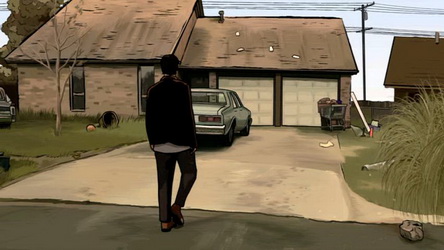 |
 |
|||||
Cassandra Cautius Our first introduction
to any character’s dwelling is when Barris and Freck reach Bob
Arctor’s house. I found the use of the rotoscoping to act differently
on the portrayal of persons than to their settings. The animation of
the backgrounds was much more subtle in its rendering; the house looked
almost real, but dilapidated. I found the animation to have the ability
to exaggerate the look and the feel of the settings throughout the film.
So there would be moments in the film where Arctor’s house would
look perfectly homely and comfortable, and other times it would emit
feelings of cramped, dirty, cluttered uncomfortable spaces. Often
times in the film this play would be based on the state of mind of the
occupants in the dwelling.
|
|||||||
| 3. | 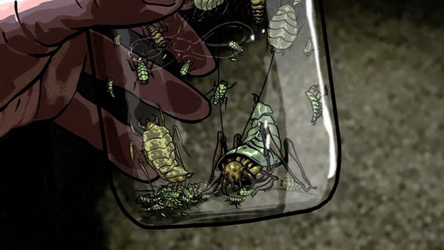 |
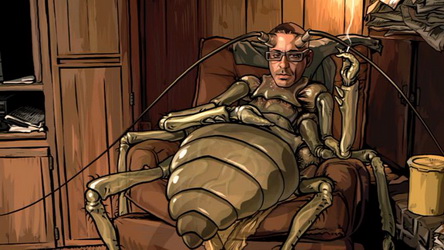 |
|||||
Alexander Chan Jim Barris is a despicable, self-seeking and treacherous character in A
Scanner Darkly. In one of the scenes where he is bumming at Arctor’s
house doing drugs, he is seen as an aphid. Aphids are minute parasitic
insects that feed off plants like lice. To see a giant aphid with a
human head is a repulsive sight on par to the vile nature of Barris.
In Arctor’s mind, due to the fact that he is taking in questionable
amounts of Substance D, he is meshing the two images together into
a sub-human amalgamation. Barris is theoretically unsettling because
of his altered physical state and the uncanny valley is relevant but
not in an extreme case. Aphid Barris would rank as a humanoid robot,
gaining empathy from viewers because he is an entity that as a whole
seems non-human but possess a distinctive humanoid bust. The bust is
enough to garner some familiarity and Barris begins to be understood
more as a cartoon than a monster. Also, as in the same case with Sin
City, the stylistic rendering of the film makes bizarre imagery
easier to digest because everything look comic or cartoon-like. Barris
has no presence in the physical reality. If he was rendered in real
time with real actors in a real environment he would very uncanny but
as he is now he is just a caricature.
|
|||||||
| x | 4. | 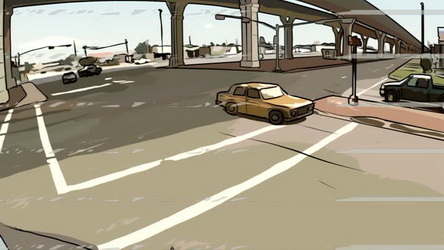 |
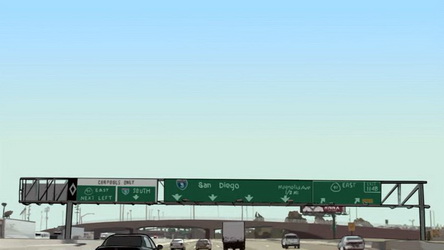 |
x | |||
David Henderson Movies set in the future are generally not realistic because the future
is unknown thus anything could be possible. The further in the future
a movie is set, the more true this is, but when a movie is set just a
few years in the future it has to be more grounded in reality. This is
what makes A Scanner Darkly so uncanny.
|
|||||||
| 5. | 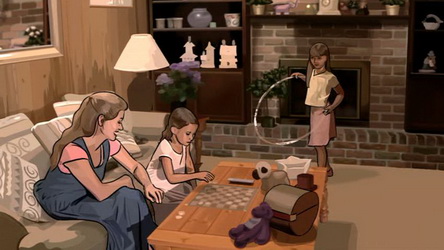 |
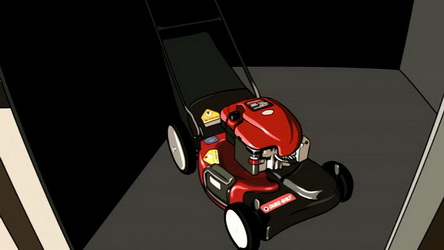 |
|||||
Minwoo Lee Prior to his life as a Substance D addict or as an undercover officer
Fred, was Bob Actor’s life as a family man. The portrayal of Bob’s
past life corresponds with many of typical nuances of an ideal family
life; a nice middleclass suburban home with a front lawn and a double
garage, wife and two children happily enjoying a game of checkers in
the living room. In such a picture perfect setting that many people consider ‘good’,
Bob was unable to find any satisfaction. The notion of a stable life
struck him as a mask for a dull life that was completely devoid of anything
new. Although this sort of resentment towards everyday life is something
that could be understood and is commonly seen, the factor which makes
it incomprehensible and uncanny is the fact that this realization which
completely alters his course of life occurs in such a random accident
as bumping your head on a cabinet door.
|
|||||||
| 6. | 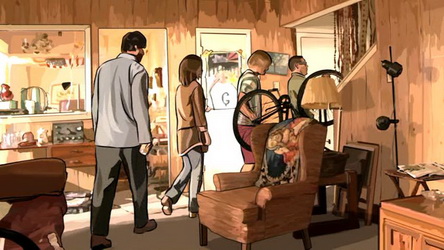 |
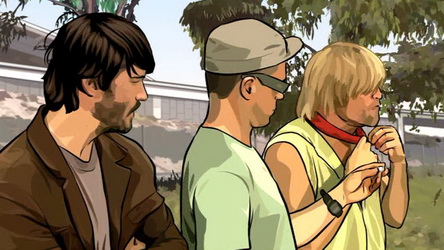 |
|||||
Paula Lee The new society faces many different issues such as condensation of population in the city centres and with it the rise of property and rent costs in these regions, and fertility drop in the western world as marriage rate dropped due to the rise of different perspectives of family and human relations. In modern world, one is focused more on self development rather than developing a family and usually these developing young individuals live in the city cores where much more is available and accessible. The old city fabric designed to suit its flats for families rather than bachelors but with much to their needs the family houses were to be shared by individuals of no blood relations. Though these individuals might not be related and strangers to each other some type of mutual trust exists between them as they were forced economically to share a house/flat. But this trust is not of same definition as the trust that exists between bloodily related family members. The trust between these strangers, and the idea of such trust between these groups of strangers are uncanny. In the film, Scanner Darkly, Bob Arctor is repeated betrayed by different people in the film, even his flatmate James Barris and his girlfriend Donna. On the outer surface, it looks as though all housemates are friendly and trustworthy but in reality there is a mutual lack of trust amongst others, which makes everyone paranoid in the film. This mistrust of people, and confusion of reality plays to bring the main theme of the film- modern creation of reality through technology and medical advancement that is against reality. The people in the film are under effect of drugs and are delirious, living under constructed reality of drugs with mutual disrespect and distrust of their neighbours and the government. The film reflects upon uncanny quality of the modern society with increased tensions of distrust between characters, their relationship with government, and themselves as they are unable to distinguish reality as is, living under constructed reality.
|
|||||||
| 7. | 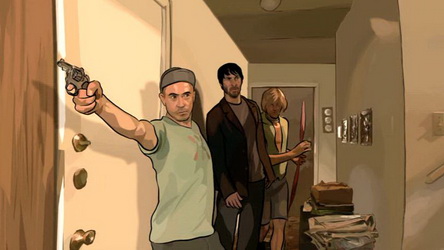 |
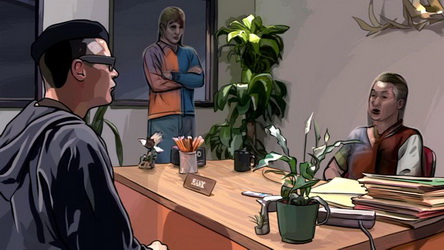 |
|||||
Evelyn Lo In
'A Scanner Darkly' the ideas of friendship are continually skewed, twisted,
and contorted to present an unnatural and unsettling depiction of trust
and betrayal furthering the disorienting and complex plot of the film.
The story of the film relies heavily on the deceptive nature of the relationships
between Bob Arctor and all those around him - his good friend and housemate,
Barris, his girlfriend Donna Hawthorne, and the corporation that employs
him as an undercover agent.
|
|||||||
8. |
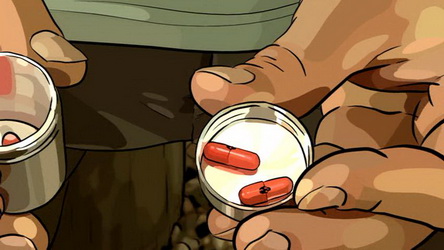 |
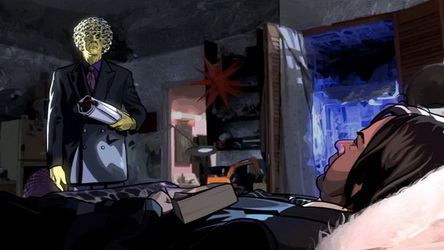 |
|||||
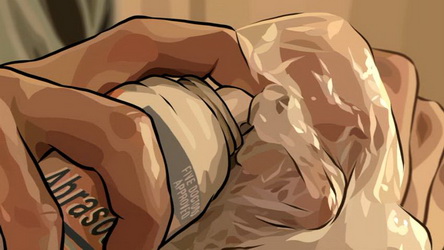 |
 |
||||||
John McFarlane The use of drugs in A Scanner Darkly is both a consequence of its autobiographical relationship to its author Philip K. Dick and a device for relating the plot to themes of persecution and ontological doubt. These themes are also related to Dick’s life and recur throughout his work. The etymology central to the story explains the Dick’s intentions regarding the use of drugs. The title, “A Scanner Darkly” refers to 1 Corinthians 13:
The biblical reference to Saint Paul and his mirror is translated into Fred/Bob Arctor viewing his own life through the scanner. Just as Fred and Bob Arctor don’t know that they are the same person, so does Dick express the inability to know himself and to “know” in a larger sense:
A Scanner Darkly is related to Substance D through the name and species of the flower it is made from: “Mors Ontologica,” meaning “ontological death” or “the death of being” or “the being of death.” The protagonist’s unsuccessful attempts to know himself are based on his addiction, which is a reflection of Philip K. Dick’s lifelong use of drugs, especially during 1970-1972 when he lived in his house with a rotating group of mostly teenage drug-users. His personal experience comes across in his writing in an attitude towards drug use that is primarily related to the consciousness expansion of the 1960s flavored with the disillusion and burnout of the 1970s. This can be contrasted with the contemporary perspective implied by the question’s use of the word “vice,” indicating an understanding of drug use as self-destruction and delusion without any notion of self-discovery.
|
|||||||
| 9. | 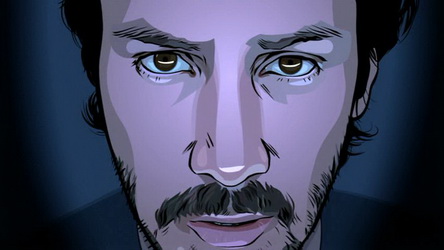 |
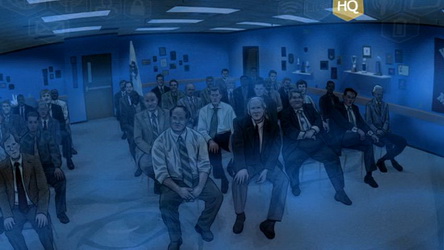 |
|||||
Sava Miokovic The suit shapes your outlook of the outside world. In the most obvious sense, it is a mask you must look through, so it effects your visual perception. The suit is a tool that gives you new abilities. The suit informs the wearer what it is doing for them through a series of symbols on the interface. For example, there is a symbol that indicates when the wearer is in communication with headquarters, when they are live, the volume of their projected altered voice, etc. The suit is very interactive. In a way it’s like viewing the world through a computer monitor. All of us constantly take on identities when we add physical things to our bodies, whether it is a baseball cap, the logo you rock, or a car you drive. The suit itself is a uniform so it has very strong associations. I think the suit penetrates the self-image of its wearer very strongly for these reasons. Thus, it also affects the way you perceive the world. The first slide represents the detachment one feels from the outside world when wearing the suit. The suit hides your physical identity, both the way you look and the way you sound. When wearing the suit, you are interacting in a world where nobody ever knows who you are. I think the suit would catalyze a strong emotional detachment, an ideal state of mind for an investigator, since they rely on rational thought. We see this in the Bob Arctor in the scene where James Barris is called into his boss’s office. Bob doesn't react at all to the presence of his friend. Its as if Barris isn't the Barris Bob knows since Bob is not Bob while in the suit. It becomes somewhat uncanny when we see Bob Arctor in the suit interacting with other agents in a suit because it’s a world where noboby knows anybody. Being social beings, this proposition is very uncomfortable.
|
|||||||
| 10. | 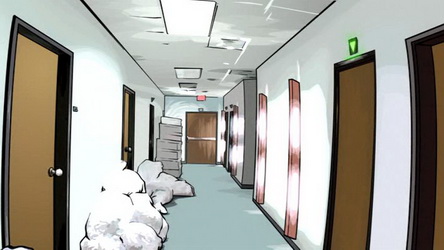 |
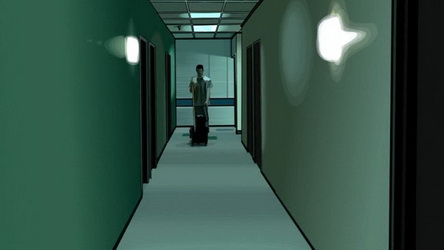 |
|||||
Reena Mistry The use of bland banal architecture emphasizes the suburban setting of the movie. The suburbs are the context for many modern films since idealistic happy neighbourhoods produce a stark contrast with disturbing characters or plotlines. Like the Truman Show or American Beauty, A Scanner Darkly utilizes the repetitious and bland settings to produce uncanny effects. Focussing on corridors alone, the repetitious and banal qualities are pushed to an extreme. The monotony of the common drop panel ceiling, unflattering fluorescent lighting and blank walls interrupted only by identical doors are the epitome of bland, characterless space. The forced one point perspective makes this boring space seem to continue endlessly. Unfortunately, this is also a space that most viewers can relate to, considering it is the common cheap corridor space, characteristic of many offices and motels. This dull space is utilized as the transition zone which juxtaposes with very strange places behind the doors of these corridors: the testing room, where Fred undergoes physical and mental tests, the surveillance room, where anonymous suit characters sit for hours watching live and recorded surveillance videos, the suit change room, the strange chamber where the identity of anonymous characters are revealed. Overall, these spaces make very unsettling and unhomely atmospheres that are equally as uncomfortable as the strange settings they lead to, though in a drastically different way.
|
|||||||
| 11. | 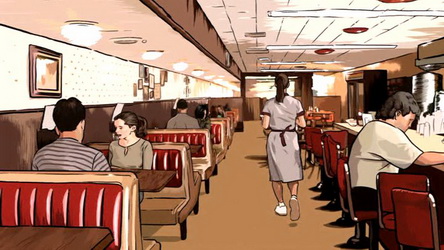 |
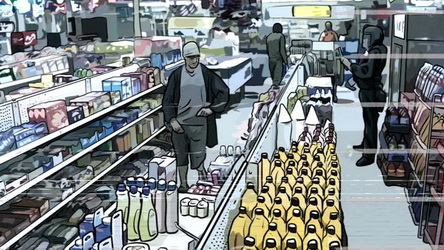 |
|||||
Melissa
Ng Scanner Darkly uses banal architecture as part of its film set to create a more believable reality in which the film takes place. The set grounds the film in its implied location – in southern United States. Whereas the projected futuristic, ultramodern architecture depicted in other films such as the original Metropolis and 5th Element create a detachment as spaces which we are unfamiliar with, the banal architecture used in the film has the opposite effect. The diner and local corner store are simple – depicted as we know and are familiar with them. These are spaces of which we can all relate to; we’ve all eaten at this diner, and we all have shopped at this local convenience store. If there were to be a slight variance in these spaces, or if an occurrence or event were to take place which would normally not happen, this space would become uncanny. However, in this film, it appears that the uncanny was not depicted through its banal architecture in its commercial setting, rather it gives the viewer a glimpse of the everyday regular routine of the American lifestyle. The architecture depicted in this manner also push the idea of paranoia, delusion, and psychosis of the characters of the film and its focus of the addiction of Substance D. The boring architecture only amplifies our perception of how delusional the characters have become through the heavy drug usage – juxtaposed to a very normal, drab world. The use of the mundane set is able to contrast with the funky behavior and provide us with a more interesting and extreme representation of the themes running through this film.
|
|||||||
| 12. | 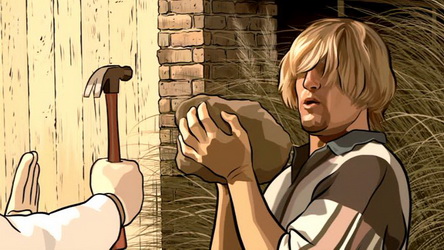 |
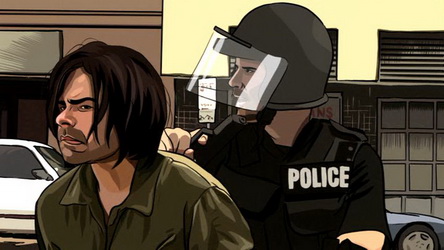 |
|||||
Aisling
O'Carroll In Richard Linklater's 'A Scanner Darkly', there is clear tension between
the protagonists, drug addicts, and the authority. Although in the film
the authority rarely comes out as being violent, there is a serious fear
of their violence among the addict characters; for example, when Freck
imagines the police officer pulling him over and shooting him. In this
case, as a viewer, we are not sure that the scene is not real until it
switches back to Freck driving, and this again changes the idea of violence
in the film. Because the story is primarily told from the place of the
addicts, there are moments, like the one mentioned with Freck, when we
are unsure of the reality of the situation, or the sobreity of the characters
to judge when to stop - like the scene where Barris and Ernie Luckman
are fighting in front of their house. |
|||||||
| 13. | 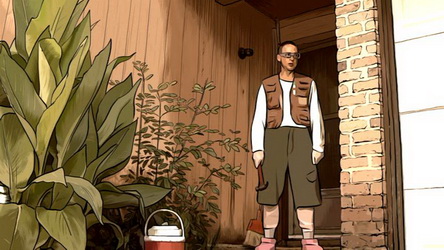 |
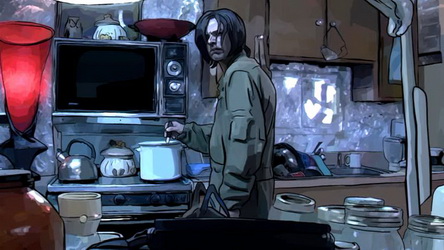 |
|||||
Shannon Ross The use of colors in Scanner Darkly enhances the uncanny feeling of the movie. The film is mostly about the abuse of hallucinatory drugs. The vision that occurs when one is on hallucinatory drugs is squewed and often cartoon like. The colors are matte and reflect the hallucinatory effect of substance D by not showing any textures simply solid colors.
|
|||||||
| 14. | 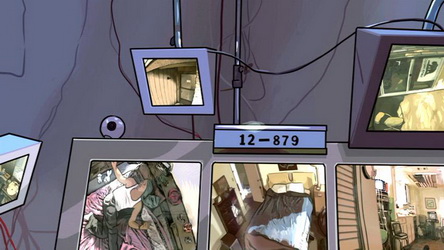 |
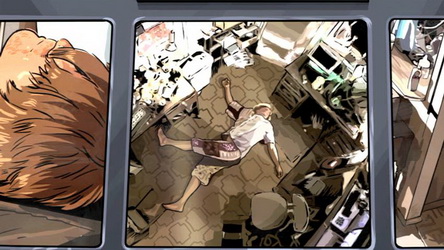 |
|||||
Terry
Sin Aside from the sense of the uncanny created by the rotoscoping technique, another uncanny aspect of A Scanner Darkly is the dual lives of Agent Fred and Substance D addict Robert Arctor, and the conflict between hemispheres. In this duality creates an ambiguous sense of time between when Arctor is Fred or Bob. This sense of time can be observed in Fred’s surveillance of his own house. Due to the nature of his job, he must observe mostly recorded surveillance tapes rather than witness streaming live feeds, preventing his identity from being deduced from process of elimination. Furthermore, the surveillance tapes also shed light on Arctor’s confusion between his hemispheres and we are able to observe his decay from Substance D. When watching Fred observe his housemates, it is difficult to tell whether it is streaming or recorded. Especially in the scene where Ernie Luckamn chokes and almost dies it is unclear whether Fred is witnessing a death or whether the death has already occurred. Fred almost begins to dial 911 right before Luckman comes back to life. However, whether or not it would have helped becomes the question. Furthermore, when Fred observes Bob, we are provided with an insight into the difficulties associated with the conflict between Arctor’s hemispheres. In one scene, Fred observes Arctor almost slipping out his police identity in a drug induced trip out. At this point we see the two halves begin to fight. In another scene, Fred reexamines the footage of waking up with “Donna”. During the live sequence, Arctor believes he hallucinates and sees Donna sleeping beside him in the morning. When Fred looks at the footage again, he apparently witnesses the same situation again. This is, of course, a very eerie phenomenon as we, as well as Arctor, are unsure whether it is still a hallucination or an actually development in the plot. Given that the scramble suits have the ability to project images, we may consider the scene to have actually happened. However, it is more likely that we observing Arctor fall into the full extent of addiction. Throughout these scenes, we are able to observe the uncanny in a variety of ways. In Fred’s viewing of Luckman’s near death experience, the relation of time to the actual events and the general sense of surveillance create an unnerving experience. When Arctor observes himself, the uncanny aspect becomes his struggle between his hemispheres. Overall, Fred’s viewings create unease due to the nature of truth and time presented.
|
|||||||
| 15. | 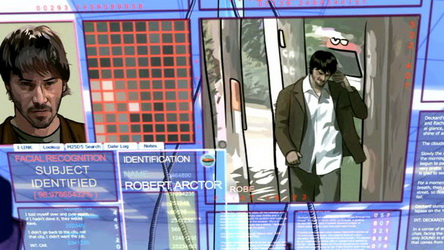 |
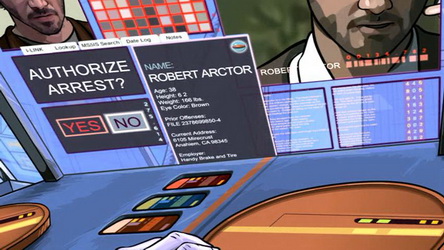 |
|||||
Helen Tout The police are asking Fred to survey Arctor because they believe he is involved with large amounts of Substance D. Fred started out as an undercover agent but quickly became allured by Substance D and became addicted. He now still works for the police but he is also an addict. The drug enables him to split up both parts of his life, so he can’t put together that he is living both of these lives. Arctor and his friends are always suspicious that they are being watched, and it turns out that they are being monitored. The police realize that Fred is undercover as a person in Arctors group, but they don’t know who. They are watching the group with two undercover agents so that they can figure out who the supplier of Substance D is. This is more important to them than losing cops to addiction. Surveillance at this time is advanced. Everyone is on the system and can be identified anywhere in the world via satellite cameras. There is high surveillance because of high addiction rates. The government wants to get the users under control and in order to do that they have invented a ‘big brother’ type of society, which runs on deceit and hidden identities. All agents where scramble suits so that people won’t know who they actually are, and therefore what case they are working. This leads to a lot of trust issues between people. Barris gives Arctor away to the cops and ignores his friend when he OD’s, clearly he does not care or trust anybody in this time of high surveillance and paranoia. Arctor knows on some level that he is being watched, but because he can no longer see who he is, he hopes that the scanners can see him clearly. It is clear that this form of government is not concerned with the life of individuals but for the overall freedom of the collective from substance abuse, hence the title, a scanner darkly. You have to wander what percentage of the police force has become addicted to Substance D because of the way the government is doing surveillance. Is this method effective in controlling the amount of Substance D in use or is this corrupting otherwise healthy peoples lives?
|
|||||||
| 16. | 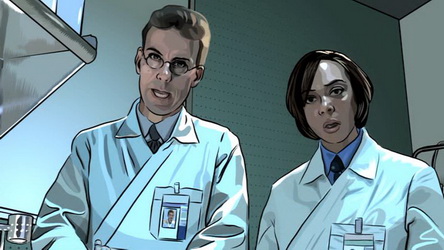 |
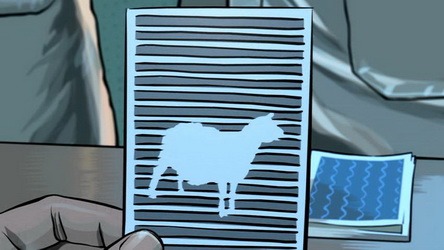 |
|||||
|
A Scanner Darkly, Directed by Richard Linklater, (Waking Life) deals with the ramifications of chronic drug abuse and the mental degeneration associated with a progressively deconstructed identity. A faithful adaptation to Philip K Dick's novel by the same title, Linklater's cinematic vision situates the viewer into a state of perpetual disorientation, rarely allowing the stability of a static frame, or the logic of a sober or rational mind. Linklater's visual style, rotoscoping, is characteristic of the drug induced haze the characters of the film exist in, while providing the element of the fantastic necessary to suspend the disbelief of viewers unfamiliar with the realities and behaviours of individuals amerced in drug culture. Through the testing of Agent Fred/Bob Arctor, the view is positioned in a state of paranoia associated with Agent Fred/Bob Arctor's own depleting mental state. During the first instance in which “Fred” is tested for mental instability, he (as well as the viewer) observes a card clearly depicting the image of a sheep. However, it is immediately brought to the attention of “Fred” (and the viewer) , by the doctors, that the image is in fact not a sheep, but a dog. It is also made clear to “Fred” (and the viewer) that the test makes no room for interpretation, and that only one correct answer exists, in this case the answer is a dog. The viewer now understands that the perceptions of the narrator cannot be trusted, and the viewer must rely on their own judgement to make interpretations regarding the characters and situations within the film. Later, during another testing of “Fred” with two, clearly different doctors, it becomes evident moments into the testing that the two different doctors are actually the original two doctors and that the perception of the viewer towards the reality of the film is hallucinatory, and therefore not objective. The viewer makes the uncanny realization that their own perceptions, and therefore judgements, are altered in the same manner as the characters under the influence of Substance D, and like the perception of the narrator, cannot be trusted. Other plot clues are also revealed during the testing of Agent Fred/Bob Arctor, such as initiative to place Agent Fred unknowingly into a New Path Clinic, in hopes of retrieving evidence of New Path's involvement in the manufacturing of Substance D. During one of Fred's visits to the doctors for testing, Fred causally inquires on the best way to impress a woman who is “hard to get close to”. The female doctor replies that he should buy her flowers, however, specifically stating that he buy her “little blue” flowers. This is a direct reference to the blue flower from which Substance D is derived and, seemingly, an attempt by the doctors to plant this information unconsciously into the psyche of “Fred”, to be remembered when he has been committed to New Path. The only discerning factor, is the inability as a viewer to trust perception, and concluded that the doctor actually mention “blue flowers”, or that this is simply another hallucination that the viewer experiences with “Fred”.
|
|||||||
| 17. | 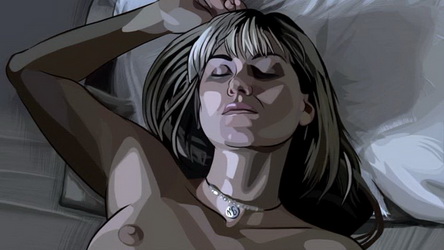 |
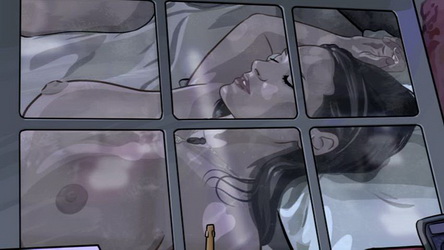 |
|||||
Susan Varickanickal Doubling as a result of confusion/hallucination in the film “A Scanner Darkly”, portrays the long term affects that the drug substance D has on its user. The mind becomes incapable of processing information correctly, and the characters in the film are unable to differentiate reality and the artificial world created by the use of substance D. A feeling of mistrust is created as the character falls deeper in the use of the illegal drug, and its effects become more lasting. The doubling affect causes the character to mistrust their own judgement, and perception of reality. In the film, the doubling of characters in order to maintain the secret identities of field agents also creates a feeling of mistrust as the deceptive lives of the characters intermingle and creates a web of confusion. Even without the use of substance D a manipulation of reality occurs as the true identities of Bob Arctor, and Donna are kept secret from each other, even though their lives in work and outside of work are interconnected. The creators of film successfully relate the contorted lives of the drug users and their misguided perceptions of reality (as doubling of characters occur through confusion/hallucination), with the deceptive nature and manipulated relationships created by doubling of characters to maintain secret identities.
|
|||||||
| 18. | 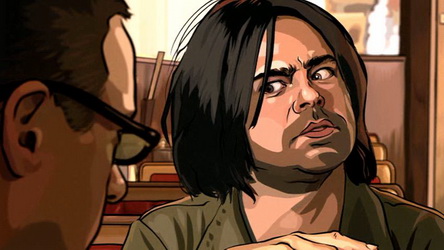 |
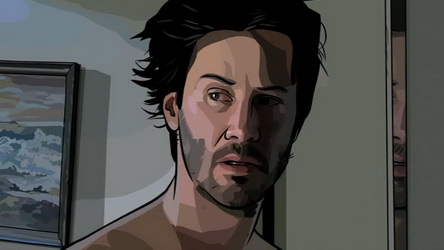 |
|||||
Chao
Lun Wang The creation of A Scanner Darkly was based on principal shooting followed by an animation post process, which uses interpolated rotoscope over the original footage. Thus the distinct rendering style of the face in the finished product benefits from both real time human expressions and abstract artistic representations. For example, certain aspects of the face are better represented by the actors’ actions in front of the camera, such as short sequences depicting the vibration of the lips, the enlargement of the retina, etc. all of which are significant details to convey one’s mood. These are not the kind of details that would usually be included in an animation. On the other hand, the overall idea of the character has gone through a successful set of abstractions in the animation process to clarify the intentions behind each character. It’s also this process of rendition that made the faces of the characters quite uncanny. For example, Earnie’s face has been rendered like a series of stop motions, seeming to miss out on certain frames in its sequence. Consequently, his facial movements does not flow, rather, they jump. This abstract rendition is coupled with the exaggerated acting of Woody Harrelson to convey a drug addict in an extremely unstable mental state of hallucination and paranoia. Similarly, the rendition of Arctor’s face is also abstracted. Heavy contrast of light and shadow are often used to represent the effect of Substance D on his character. The duality of tone correlates to the development of a split personality of Arctor and Fred and his cognitive problems due to the psychoactive drug. For all the characters in the film, the rendition of the face occurs on two layers, a live action shot, and a post-process animation. The result is distinct portrayal of the character that is seemingly real yet abstract and uncanny.
|
|||||||
| 19. | 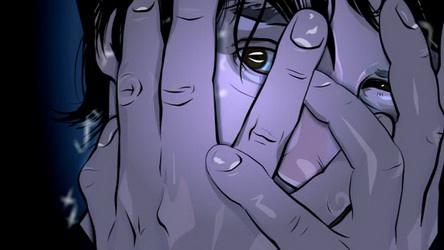 |
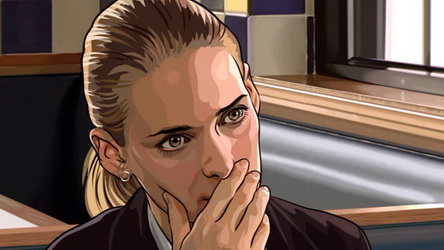 |
|||||
Benjamin
Wong The emotion of realization is perhaps one of the hardest to convey in animation. In contrast to the extremity of emotions portrayed in Renaissance, A Scanner Darkly attempts to animate the subtle movements of the face. The storyline of both films differs greatly, as does the use of animation techniques. It was perhaps more important for Linklater’s film to be able to recreate human emotions as 2D objects, simply because of the nature of the movie. The film’s success in this aspect is perhaps due in great part to its reliance on the technique of rotoscoping, as well as the actors’ abilities to play their roles compellingly. This technique, which is basically tracing over the actors’ faces frame by frame, gives the animators the most direct way of drawing realistic human emotions. A Scanner Darkly - unlike Renaissance, which created characters based on human creativity – transferred the actors’ faces in a very literal way. Rather than attempting to create a moving graphic novel, the film used animation to allow freedom to manipulate every frame of the movie. Rotoscoping then, not only allows for a stylized but realistic translation of real facial expressions, but the opportunity to exaggerate or edit out certain elements. This careful editing and complete control of the film is certainly unique to animation. The actors in A Scanner Darkly themselves explain that they often tried to exaggerate their emotions during the filming, in order to allow the animators to more easily understand their facial expressions. It is really just this detailed understanding that was necessary for the animation; detail that is rarely available in anyone’s imagination. Although Sin City is an excellent example of how real actors can be combined with an animated set, there is still a lack of complete control over the actors’ expressions. Whereas A Scanner Darkly captures the natural changes in human faces, but also alters them to be more “perfect”. This success in portraying subtle emotions is key to eliminating the uncanny aspect of the characters. The uncanny plays a part only with the drastic distortions of the characters, such as the scramble suit, or when Arctor hallucinates and sees his friends as giant insects with talking human heads.
|
|||||||
| 20. | 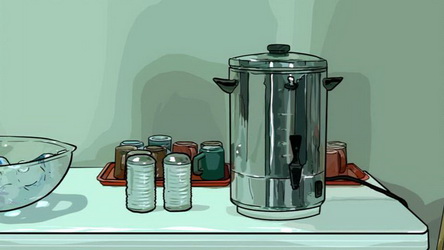 |
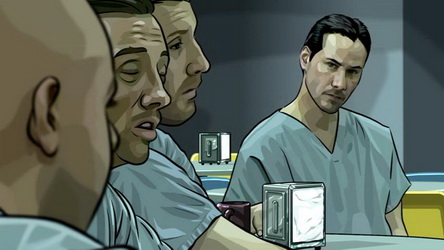 |
|||||
Erin
Corcoran The element of the rehabilitation centre in Scanner Darkly is uncanny in its counter-intuitive relationship to the outside world. In traditional definitions of a rehab, it is understood as a helpful human place where junkies enter, are changed through being removed from their inhuman environments and lifestyles, and then, once cured, they are re-entered into the so-called ‘real world’. Within the Scanner Darkly New-Path Rehab, this relationship, at least from the point of view of the viewer, is reversed. In comparison to the outside world, the rehab seems inhuman, sterile, empty and lifeless, unlike the situation outside that is colorful, human, and feels, generally, more real. New-Path is also considered to be a somewhat mistrustful corporation, where instead of helping junkies to eventually re-enter society, it is in fact the very source of the drug that got them into the rehab to begin with. It treats the individuals within the centre as less than human, as both the by-product of the drug they are flooding the world with, and also the perfect, unquestioning workers they use to harvest the drug. Instead of a circle of healing, the rehab in Scanner Darkly is a cycle of deeper and deeper addiction. Lastly, and perhaps the most uncanny element within rehab is the behaviour of its inhabitants. Whether junkies or staff, the people within the New-Path system either come off as robotic brain-dead zombies or happy but evilly grinning facilitators. It is as if by entering this rehab environment the individuals lose the very behaviours, gestures and elements that make them human at all. Instead of regaining their forgotten humanity, the people within the rehab, both workers and patients, become uncanny and somewhat robotic in their activities, further emphasizing the inhuman elements of the Scanner Darkly rehab.
|
|||||||
| 21. | 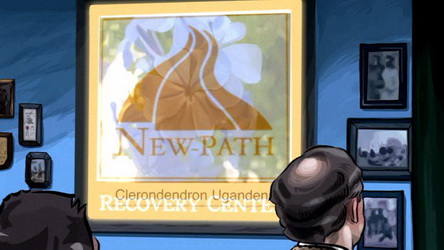 |
 |
|||||
Matthias
Heck In the drug-ridden future Richard Linklater portrays in his film adaptation of Philip K. Dick's "A Scanner Darkly", New Path is a corporation that runs a series of rehabilitation clinics which seem to be the only feasible solution to deal with the massive problems of the population's addiction to substance D. As we can tell from a discussion about New Path between Barris and Freck, people obviously don't know anything about the true machinations of this corporation. Though we, as the audience, get a small hint in the beginning of the movie, when Arctor takes a speech at the Brown Bear Lodge and we see the New Path logo, it is not until the final moment of the movie that the true identity of New Path is revealed and we understand this hint about the scheming of a shady corporation, that is ultimately the source of the whole substance D issue. As the storyline develops, Arctor is finally brought to the rehab, and the first, superficial, glance of the recovery centre evokes the association of a normal recovery clinic. The blue and white logo of New Path that we see at the Brown Bear Lodge gathering, and then again inside the rehab centre, shows a wanly blue flower in the background. The blue flower is a very strong symbol with historical roots: it was a central, recurring symbol in German romanticism, and stood for love and desire, but also evolved into a symbol of hope. Other sources see it as "a symbol for the simultaneous end to and beginning of all things, for reinvention and reincarnation…". Given this hopeful meaning in the context of the recovery centres seems plausible and evokes the feeling of a respectable institution that is concerned about the health of people. After a period of psychological reconditioning treatment (which seems more like determining the state of mind and the aptitude for mindless drone assignments), but still suffering from serious brain damage, Arctor gets transferred to an isolated, prison-like farm, where he receives a new name, Bruce, and is supposed to do unpretentious farming work. The clean and respectable character of New Path, represented through their logo, facilities and their general image, changes gradually as it turns out to be a bogus rehab. It is not until the final scenes of the movie that we see the big picture of New Path taking advantage of the mental state of substance D users, as the corporation uses them for its own purposes, growing the flower that is used for distilling substance D. This is uncanny and frightening in many ways: we not only have a misrepresented corporation with crooked intentions, but also one that is in fact able to fool the government, as it is more influential and powerful. New Path's intentions and actions furthermore lead to an Orwell's Big Brother-like state of government control and oppression. Also, with Arctor's tragic entanglement, we see the price the state has to pay in order to try to find out the truth. Regarding Philip K. Dick and his personal background, this dystopic scenario, misuse of power, the surveillance state, drugs & paranoia and the state of mind of his characters are recurring themes in Dick's books, and certainly notions that are supposed to lead to a personal debate on one's view of life.
|
|||||||
| 22. | 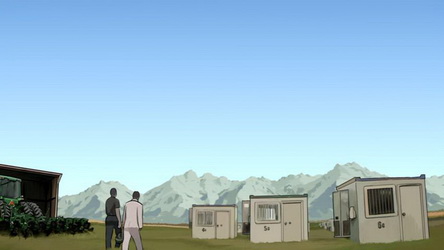 |
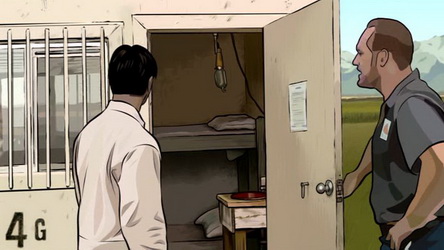 |
|||||
Suzanne Gibson The farm scene is significant in that it ties the sub plots of the movie together, and although it doesn’t answer the questions it poses it does clarify them. It raises questions about the complex linkage between authority and drug commerce. Is it acceptable to supply damaging drugs to unknowing participants in order to gain insight into larger operations. Donna, Arctor’s superior, girl friend and drug dealer, (although he is unaware that she is his superior) uses him to infiltrate New Path to find the source of their funding. But in doing so she destroys him, the drugs causing a complete mental collapse. And this makes one question if it is acceptable to have a relationship between police and criminals, has the authorities gone too far in allowing Donna to date Arctor, and should Arctor be allowed to watch over his friends, it is a weird sensation watching Arctor watching himself and his friends in his house, there is something perverse about it. And it becomes even more disturbing when Arctor metal capacity begins to collapse; there is a point when Arctor seems to become unaware that he is watching himself. To further this weird sensation, Donna who at first the viewer is not aware that she is Arctor’s superior is over watching the whole operation. Which raises the next question, is it justifiable to sacrifice and individual without their knowledge for the greater good. To gain access to New Path a rehab facility, the police allow and to a point encourage Arctor drug uses, he becomes an addict to Substance D, the result is the two hemispheres of his brain have become dislocated from one another, and begin to function independently creating two personas, which the characters is incapable of recognizing. He acts and functions as two different people, who are unaware of each other, couple with halogenations. Creating a strange world where the viewers and the characters become detached from reality, and there are points in the movie where one loses track of reality. The result of the drug use is Arctor being discharged from the police services, he is placed in rehab, and unbeknown to him he is being used. The film ends with Arctor, a shattered man working at New Paths farming community, as he walks along the rows of corn he realizes that the ground is covered in blue flowers, the source of Substance D, although the viewer does not know for certain if Arctor is aware that the flowers are the source of Substance D, or if he is just taken aback by them attracted by their color, or maybe at that moment he knows he has been used. The farm is traditional a symbol of growth and renewal, but in this case it is not. Those that tend the crops are incapable of recovery, the lights are on yet the individuals are unresponsive and the possibility of their recovery is slim. And sadly the drugs are cared for and harvested by addicts who are so far gone they don’t even know that they harvesting the drugs that lead to their demise.
|
|||||||
| 23. | 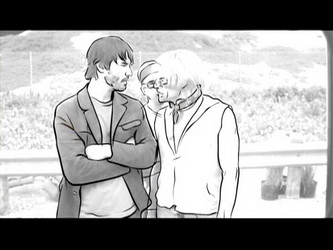 |
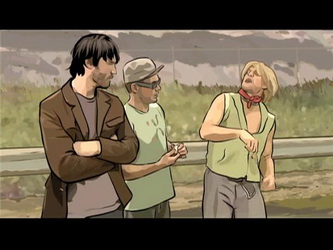 |
|||||
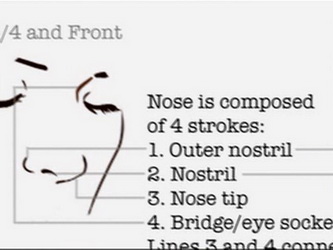 |
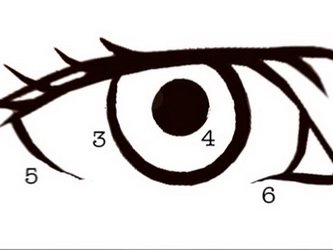 |
||||||
 |
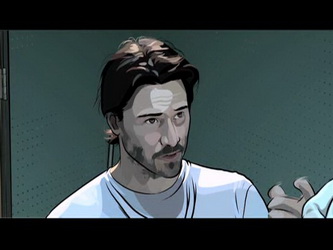 |
||||||
Kate Gould The film A Scanner Darkly is like a graphic novel come to life, presenting a haunting, highly stylized vision of our near future. The film shows a drug-addicted individual’s journey into deep destabilizing paranoia and the animation technique of interpolated rotoscoping was essential in producing this atmosphere. Animation Technique Basic rotoscoping used in the past involved the exact animated duplication of a filmed sequence, one frame at a time. As this could be very time consuming, artists would often skip frames, which resulted in a very jumpy look, such as that seen in A-ha’s 1985 music video “Take on Me”. However, rotoscoping was brought into the digital age with software called Rotoshop (similar to Photoshop) which was developed by Bob Sabiston, a software designer and filmmaker. This software had the ability to guess, or interpolate, what the skipped images between the drawn frames would look like. Therefore, the interpolated lines and shapes have very smooth, fluid motion, which would have been extremely difficult to achieve with hand-drawing. Other features of the software also cut down on the animation time such as the ability to break the drawing into different layers and freeze certain layers during the animation, as in Photoshop. For example, this could freeze the background, such that it didn’t need to be drawn in every single frame. Overall this form of animation allowed the animators to do extremely lifelike hand-drawn animation, with great ability to animate the facial expressions and gestures. As there were so many artists working on each of the characters they needed to make templates of each of the characters, as seen in the second set of images, to make sure that the style remained consistent. Uncanniness of Film Many Hollywood movies would utilize special effects to create scenes such as those in A Scanner Darkly and in comparison to both Renaissance 2054 and Sin City this was a relatively low-budget film. However, as the film involves a first hand depiction of drug-induced paranoia and delusions, the animation is able to remove it just one step from reality which makes it particularly uncanny. The technique creates a really effective feeling of a drug trip or lucid dreaming, where there is a feeling of everything being just a little “off””. For example, they use subtle effects, such the background warping and distorting around the characters, or more extreme effects, such as Jim and Ernie turning into cockroaches. The one part of the movie would have been near impossible in live-action filming would have been the depiction of “the suit”. These scenes involved many different animators creating artificial characters and then animating each scene with each of them and then finally blending between them. Hence, the process of rotoscoping gave this movie, a relatively low budget film, the ability to add limitless visual effects. Anything was possible, as long as animators could draw it, which was particularly uncanny as it had the ability to question our reality.
|
|||||||
updated 23-Dec-2007 10:39 PM